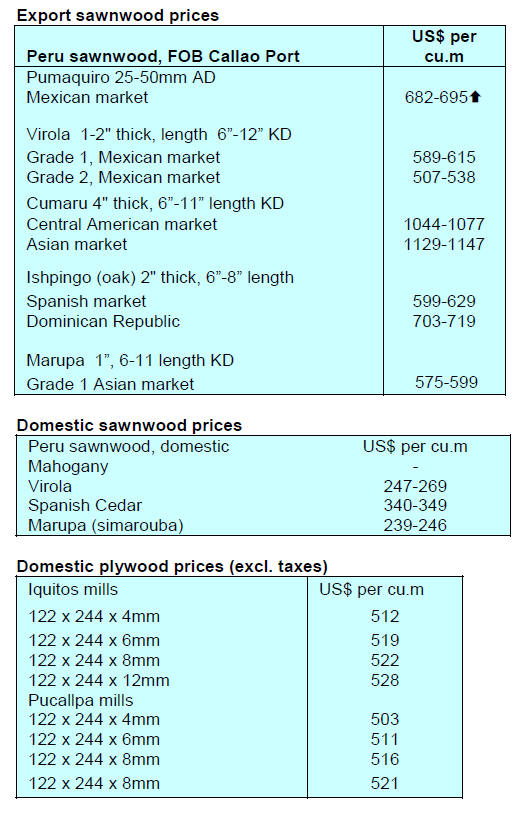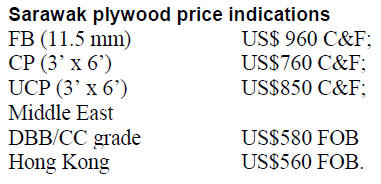
4.
INDONESIA
Indonesia-UK to expand trade
At a meeting between Indonesian Foreign Minister Retno
Marsudi and British Minister of Foreign Affairs,
Commonwealth and Development, Elizabeth Truss, there
was agreement to strengthen bilaterally and multilaterally
cooperation.
To promote trade in wood products representatives from
the Ministry of Environment and Forestry together with
the Association of Indonesian Forest Concession Holders
(APHI) joined the Indonesian delegation in London to
discuss the issues related to the wood products trade.
The Indonesian side emphasised the urgency to expand the
understanding of UK consumers regarding aspects of
legality and sustainability to encourage more sales.
Currently the market for wood products in the UK is
estimated to be worth US$15 billion annually but
Indonesia’s share is only around 2%.
See:
https://forestinsights.id/2022/04/21/indonesia-inggrissepakat-perkuat-kemitraan-termasuk-perdagangan-produk-hasilhutan/
Promoting legal trade with China
Companies in the forestry and wood products sectors have
reached out to counterparts in China in an effort to jointly
promote markets for sustainable wood products. The
chairman of the Indonesian Forestry Community
Communication Forum (FKMPI), Indroyono Soesilo, said
both countries needed to eliminate trade in illegal timber.
This was the conclusion of an online forum ‘Promoting
Legal and Sustainable Timber Trade Between China and
Indonesia’.
This can be achieved as China is expected to introduce a
green procurement policy to increase the demand for
legally sourced and sustainable wood products.
Zhang Liyan, from China’s National Forest Product
Industry Association (CNFPIA) said Indonesia continues
to be a major wood product supplier to China.
See:
https://forestinsights.id/2022/04/15/indonesia-ajak-chinapromosikan-produk-kayu-lestari-tingkatkan-volumeperdagangan-kedua-negara/
Cracking down on carbon projects linked to illegal
forest operations
Indonesian Environment and Forestry Minister, Siti
Nurbaya, has identified a number of carbon projects
underway in the country's state forest areas that are or
could be associated with illegal forestry operations. The
Minister said this will be stopped and warnings and
sanctions are being imposed.
On the positive side the Minister mentioned a new carbon
offset deal with a major oil and gas company operating in
Sumatra’s Riau Province involving ecosystem restoration
in Central Kalimantan.
See:
https://foresthints.news/minister-cracks-down-even-harderon-carbon-projects-linked-to-illegal-forestry-operations/
Free trade deals could lead to shortages for domestic
manufacturers - Association
The Asean/Hong Kong free trade deal will encourage
exports but there is a risk that expanded trade could result
in higher prices and reduced supplies for domestic
furniture makers according to the chairman of the
Indonesian Furniture and Craft Industry Association
(HIMKI), Abdul Sobur.
He called on the government to discuss regulating what
categories of products can be exported because if the raw
material trade is not regulated the domestic furniture
industry will find it difficult to achieve the export value
target of US$5 billion by 2025.
See:
https://ekonomi.bisnis.com/read/20220420/257/1525091/perdagangan-bebas-asean-hong-kong-bahan-baku-kayu-berpotensiterbang-keluar-ancam-mebel-domestik

5.
MYANMAR
Challenges of power interruptions and
depreciation of
the Kyat
During the past two weeks news relating to energy and
foreign currency are hot topics. On 3 April the Myanmar
Central Bank issued a regulation requiring incoming
foreign currency to be converted to kyat. (see MIS Report
Volume 16 Number 7, 1-15 April 2022).
However, according to a directive issued by the Central
Bank on 26 April, exporters trading under China-
Myanmar and Thai-Myanmar border trade programmes no
longer need to compulsorily convert their export earnings
in foreign currencies into kyats within one working day.
However, it must be exchanged within three months.
Other changes were made exempting businesses operating
in economic zones approved foreign investors, embassies,
United Nations agencies and non-government
organisations.
In related news, Myanmar traders have welcomed the
move to allow private banks to offer renminbi (RMB)
accounts saying this will increase opportunities for border
trade. Four private banks in Myanmar have been allowed
to provide RMB accounts in order to facilitate the process
of payment in China-Myanmar border trade.
See:
https://elevenmyanmar.com/news/myanmar-relaxescurrency-conversion-order-for-traders-at-china-thailand-borders
Power outages plague manufacturers
In recent weeks Myanmar has been hit by a series of
power outages forcing industries to rely on alternative
power supplies such as generators which consume a
considerable amount of diesel. Power outages and soaring
fuel prices are driving up prices and increasing uncertainty
for the country’s businesses.
In order to maintain power supplies the authorities plan to
accelerate development of hydrocarbon and renewable
energy sources and are seeking to increase foreign
investment in the sector despite the threat of economic
sanctions.
According to the state run newspaper it has been proposed
including the Mee Lin Gyaing Project and a LNG power
plant and gas pipelines connecting with Yangon in the list
of projects in the China-Myanmar Economic Corridor
(CMEC).
See:
https://www.irrawaddy.com/news/burma/myanmarfactories-to-close-amid-planned-power-cuts.html
Information sources limited
The security situation is very uncertain as fighting
between the military and opposition forces has intensified
and this is making it increasingly difficult to get
information from the country. For an analysis of the
current situation:
See:https://www.japantimes.co.jp/news/2022/04/25/asiapacific/tom-andrews-myanmar-interview/
6. INDIA
Wholesale price
indices for March 2022
The Office of the Economic Adviser, Department for
Promotion of Industry and Internal Trade has published
wholesale price indices for March 2022. The index for
manufactured products increased to 141.6 in March 2022
from 138.4 for February 2022.
Out of the 22 manufactured products in the index, 18 saw
increases in prices while 3 groups saw declining prices in
March 2022 as compared to February 2022. The increase
in the overall index was mainly contributed by rises in
prices of basic metals, food products, chemical products
and textiles.
The annual rate of inflation was 14.55% in March 2022 as
compared to 7.89% in March 2021. Price inflation for
wood products and cork items over the past six months to
March 2022 was 5.76%, 5.49%, 5.32%, 4.11%, 4.55% and
4.65%.
See:
https://eaindustry.nic.in/pdf_files/cmonthly.pdf

India, a US$28-30 trillion-dollar economy by
2050
India’s GDP growth is one of the fastest in the world
according to the International Monetary Fund (IMF). The
IMF has projected a "fairly robust" growth of 8.2% for
India in 2022.
Speaking at the India economic conclave 2022 'The Great
Indian Democratic Dividend' Gautam Adani, founder and
chairman of the Adani Group said India's demographic
dividend will mean the country is on track to becoming a
US$28-30 trillion-dollar economy by 2050.
Adani said, "My optimism comes from my belief that no
nation in the world is as uniquely well placed as India to
capitalise on four major vectors that will accelerate
development.
These are the pull from India’s demographic dividend,
growth of the middle class, push from the accelerated
digital economy and the sustainability focused economy."
See:
https://economictimes.indiatimes.com/news/economy/indicators/india-to-be-a-30-trillion-economy-by-2050-gautamadani/articleshow/90985771.cms?utm_source=contentofinterest&utm_medium=text&utm_campaign=cppst
Home sales surged in first quarter
According to a report from ProTiger.com home sales and
housing starts set a record high in the first quarter of this
year. Sales in the first quarter were the highest since the
Covid outbreak.
Markets included in the ProTiger report are Ahmedabad,
Bangalore, Chennai, Hyderabad, Kolkata, Mumbai
Metropolitan Region, Delhi-National Capital Region and
Pune.
Mumbai and Pune had the biggest share in housing sales,
with their combined share standing at 56% of overall
sales.
See:
https://economictimes.indiatimes.com/industry/services/property-/-cstruction/housing-sales-grew-by-7-y-o-y-jan-march-quarterwas-best-since-covid-outbreakreport/articleshow/90562277.cms?from=mdr
In related news, a UK-Singapore joint venture plans to
introduce Laminated Veneer Lumber (LVL) for housing
projects in India tosubstitute wood for conventional
building materials and help expand low-carbon
construction by substituting wood for steel and concrete.
See:
https://theprint.in/world/uk-singapore-joint-venture-tointroduce-engineered-timber-for-housing-in-india/921559/
Poplar log prices surging
Prices for poplar logs have reached an all time high much
to the delight of forest owners in Yamunanagar in the
Indian state of Haryana. This area is known for the clusters
of plywood and paper industries. It has been reported that
prices for poplar logs have reached a high of Rs 1,400 per
quintal (1 quintal = 100KG).
Plywood factories in Yamunanagar used to source most of
the poplar wood from a neighbouring state but supplies
have dropped. While the increased price for logs is good
news for suppliers the overall decline in log supplies has
meant mills have had to cut production.
Haryana Plywood Manufacturers’ Association Presiden,t
JK Bihani, claims that reduced supply was adversely
affecting the plywood industry in the district. Traders
report that prior to the Covid lockdown two lakh quintal of
poplar and eucalyptus logs was available every day but
now the supply has come down to about one lakh quintal
per day.
See:
https://www.tribuneindia.com/news/haryana/farmersupbeat-as-poplar-wood-rate-at-all-time-high-385836


Greenply shipments from Ikolo SEZ
A report from the Bank of Central African States (Beac)
says Gabon should experience increased wood production
in the second half as the Ikolo Special Economic Zone
(SEZ) becomes operational. The media in Gabon has
reported that Greenply (a major producer of wood panels
in India) has made early shipments of veneer to its
operations in India.
Greenply, along with the other companies operating in the
Ikolo SEZ, plan to create 750 to 1,250 jobs for Gabonese
by the end of 2023 and export between 300 and 400
containers of processed wood products every month,
See:
https://www.lenouveaugabon.com/fr/economie/2104-18352-bois-hausse-projetee-de-la-production-gabonaise-au-2etrimestre-2022-grace-a-la-zes-d-ikolo
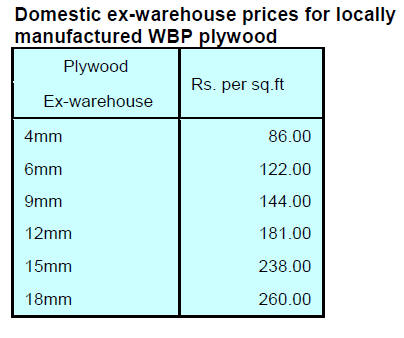
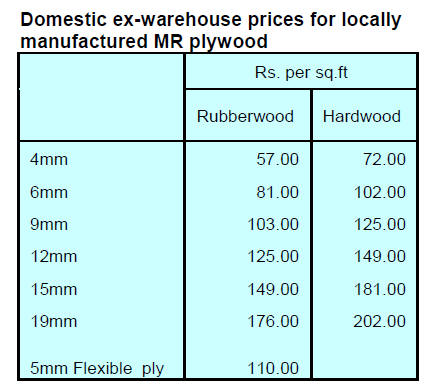
7.
VIETNAM
Wood and wood product trade highlights
The Vietnam General Department of Customs has reported
wood and wood product (W&WP) exports in April 2022 at
an estimated at US$1.5 billion, up 7.3% compared to April
2021. In the first 4 months of 2022 exports of W&WPs
is estimated at US$5.48 billion, up 5% over the same
period in 2021.
Of the total exports of WPs in April 2022 have been
estimated at US$1.13 billion, up 6.4% compared to April
2021. In the first 4 months of 2022 WP exports were
worth US$4.14 billion, up 3% compared to the same
period in 2021.
Padauk wood imports in April 2022 are estimated at
19,200cu.m worth US$7.5 million, up 20.4% in volume
and 20% in value.
In the first 4 months of 2022 padauk wood imports were
estimated at 59,200 cu.m, worth US$24.7 million, down
6.5% in volume and 4% in value compared to the same
period in 2021.
Vietnam's exports of rattan, bamboo and other NTFPs in
March 2022 reached US$89.06 million, up 32% compared
to February 2022 and up 14% compared to March 2021.
W&WP exports has gained nearly US$4.0 billion in the
first quarter and optimistic with the target of US$16 billion.
According to the Import-Export Department of the
Ministry of Industry and Trade (MT) many wood product
export enterprises have orders until the end of the third
quarter of 2022. With this pace of growth the timber
industry's target of US$16 billion in 2022 can be achieved.
International demand for wood products and wooden
furniture continues to rise and businesses in the timber
industry, especially the furniture manufacturers have full
order books until the end of the third quarter or even the
end of 2022.
Vietnam's production and export activities are being
promoted by a series of agreements that are being
implemented such as EUFTA and CPTPP creating a
competitive advantage for enterprises.
As China is implementing a "Zero COVID" strategy
export production has been affected which also gives an
advantage to Vietnam.
However, the impact of the COVID-19 pandemic and the
war between Russia and Ukraine is causing businesses to
face a shortage of shipping opportunities, a lack of
containers, rising freight costs which is leading to
disruption of supply chains.
In the first quarter 2022 W&WP exports to the main trade
partners all grew except for China and Canada. The US
continues to be Vietnam's top export market for W&WPs
and in the first quarter was worth US$2.4 billion, up 4%
over the same period in 2021.
Exports to Japan were worth a further US$396 million, up
11%; to South Korea US$249 million, up 18% while to
China exports were worth US$353 million, down by 1%.
See:
http://asemconnectvietnam.gov.vn/default.aspx?ZID1=8&ID1=2&ID8=118638
In the first quarter of 2022, imports of wood raw
materials from Africa increased again
In early 2022 due to the limited supply of wood raw
materials from the US and the EU and the rapidly rising
prices, Vietnamese wood processing and trading
enterprises have been facing a serious problem.
In the face of these difficulties Vietnamese timber
importers intend to increase wood imports from African
suppliers while recognizing such imports come with
legality risks.
After consecutive declines in 2020 and 2021 imports of
wood raw materials from Africa increased again in the
first quarter of 2022 and were estimated at 300,000 cu.m
worth US$110 million, up 17% in volume and 21% in
value over the same period in 2021.
In the first two months of 2022 imports of wood raw
materials from Africa reached 187,450 cu.m worth
US$68.5 million, up 28% in volume and 31% in value
over the same period in 2021.
See:
https://goviet.org.vn/bai-viet/quy-i-2022-nhap-khau-gonguyen-lieu-tu-chau-phi-tang-tro-lai-9716
Acacia plantation development
In the last three decades Vietnam has been emerging as a
‘kingdom of the acacia tree’. The timber industry
development of Vietnam will not be a success without the
immense growth of acacia plantation. However, the use of
inappropriate varieties and improper seed propagation
technologies, unsustainable management techniques have
led to a poor perfomence acacia plantation busineses.
At present acacia plantations extend over 2.2 million
hectares accounting for about 60% of the total commercial
planted forest area in Vietnam.
Acacia mangium, acacia auriculiformis, acacia hybrid (a
hibrid of these two varities) and acacia crassicarpa grow
well on altitudes under 700 m above sea level.
These acacia species have an important role in regreening
baren lands and denuded hills, improving land
reclamation, helping erosion control and providing being
the main source of raw materials for the wood processing
industries. Acacia plantations have greatly contributed to
poverty alleviation for a large segment of Vietnamese
rural population.
Of the total wood and wood product export revenue of
US$14.8 million around half was manufactured from
acacia.
Neverthless, improper planning nd the extensive planting
on land with the wrong site conditions along with a too
short cutting cycle (4 – 6 years) along with other factors
has lowered potential and the efficiency of the entire
acacia value chain.
In many localities, farmers are still planting acacia on land
with inappropriate climatic and soil conditions (over 700
m above sea level, too steep slopes and high frequency of
storms. As a sesult, in certain areas, acacia plantations are
blamed for landslides and other negative impacts on the
environment. To address this situation the Ministry of
Science issued Standards on site requirements for acacia
mangium (TCVN 11366-1:2016), acacia auriculiformis
(TCVN 11366-3:2019).
In commercial plantation businesses seed source and
seedlings treatment are key factors that determine the
health, productivity and quality of plantation forests.
Improved seeds have contributed to increase the average
yearly yield of acacia plantations from 15 cu.m to over 20
cu.m per hectare.
The Ministry of Agriculture and Rural Development has
recognised many varieties of acacia for planting. However,
the number of varieties commonly used is still limited, the
transfer of new varieties remains slow and the life span of
using certain plus trees in nurseries for seed breeding is
too long leading to vigour.
Another factor affecting the yield and quality of acacia
plantations are the technical measures to intensify
plantation performance. Many farmers are still practicing
extensive plantation establishment, with extremely high
planting density (even 3,500 – 4,000 stems per hectare)
and without thinning. With such high density, trees are
often small in diameter, the vegetation under the plantation
canopy is unable to grow and reduced water penetration
accelerating erosion and landslides in high-slope locations.
South Africa - the largest supplier of padauk wood for
Vietnam
In the first 3 months of 2022 imports of padauk sawnwood
totalled 35,300 cu.m worth US$15.4 million, down 12% in
volume and 3% in value over the same period in 2021.
Imports of padauk logs amounted to 4,700 cu.m worth
US$1.8 million, up 13% in volume and 22% in value over
the same period in 2021.
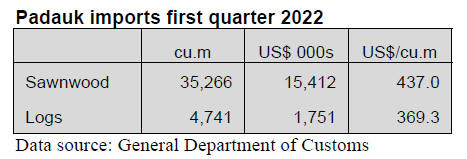
The average price of imported padauk in the first 3
months
of 2022 was reported at US$429.0 per cu.m, up 16% over
the same period in 2021.
In particular the price of padauk logs imported from South
Africa increased by 1.4% compared to the same period in
2021 to US$274.7 per cu.m; from the Angola prices
increased by 13% to US$279.0 per cu.m; from Namibia
rose 12% to US$269.70 per cu.m and from Cameroon
US$404.50 per cu.m, up 8%.
In the first 3 months of 2022 imports of padauk from
Angola, Congo, Hong Kong and China declined against
the same period in 2021 while imports from South Africa,
Laos, Namibia, Cameroon and Gabon increased.
Imports of padauk from Angola reached 4,700 cu.m, worth
US$1.3 million, down 69% in volume and 65% in value
compared to the same period in 2021 and accounted for
12% of total imports in the first 3 months of 2022.
Imports of padauk from the Congo was 1,700 cu.m, worth
US$628,000, down 9.0% in volume and 18% in value
compared to the same period in 2021.
In contrast, padauk imports from South Africa increased
by 22% in volume and 23% in value over the same period
in 2021, reaching 15,500 cu.m, worth US$4.3 million,
accounting for 39% of total imports.
8. BRAZIL
Monitoring technology in the
Brazilian Amazon
The ‘Providence Project’ which began in 2016 led by the
Mamirauá Institute together with the Polytechnic
University of Catalonia (Spain) has promoted progress in
monitoring biodiversity in tropical forests. This has been
achieved through developing a technology that integrates
species recognition through audio and image techniques.
This technology is being applied in the Mamirauá
Sustainable Development Reserve to identify and track the
biodiversity in 1.1 million hectares of protected Amazon
forest.
‘Providence’ techniques also provide information on the
‘health’ of the forest through calculation of eco-acoustic
indices of biodiversity. This technique allowed automatic
real time identification of more species than any other
technology available. The impact of this technology will
be significant.
See:
https://www-mamiraua-orgbr.translate.goog/noticias/reserva-mamiraua-na-amazoniacentral-e-a-primeira-do-planeta-a-ser-monitorada-inteiramenteem-temporeal%20?_x_tr_sl=pt&_x_tr_tl=en&_x_tr_hl=en&_x_tr_pto=sc
Technology to support transparency of information
The Brazilian Institute for the Environment and
Renewable Natural Resources (IBAMA) have launched a
technology that supports transparency of information on
products from natural forests in Brazil.
The programme called ‘Analytical Panels of Timber
Management’ developed by the Federal Service of Data
Processing (SERPRO) will make public data on logging,
production, processing, commercialisation and transport of
forest products.
According to IBAMA sustainable production is one of the
most important public policies to combat illegal
deforestation. The information is obtained from the
processing and cross-referencing of data from several
integrated federal and state control systems. There are
three main categories, information on wood production,
timber processing and trade and transport of wood
products for export.
The system delivers details on authorisations granted by
environmental agencies and projects under analysis,
transactions of forest products in the national market and
export transactions.
The technology originated in 2020, with the creation of the
Sinaflor+ system (National System for the Control of the
Origin of Forest Products) which established the
obligation to adopt mechanisms for the traceability of
wood at origin.
See:
https://www-madeiratotal-com-br.translate.goog/governofederal-lanca-tecnologia-que-facilita-controle-e-fiscalizacao-daexploracao-da-madeira-nativabrasileira/?_x_tr_sl=pt&_x_tr_tl=en&_x_tr_hl=en&_x_tr_pto=sc&_x_tr_sch=http
Export update
In March 2022 Brazilian exports of wood-based products
(except pulp and paper) increased 30% in value compared
to March 2021, from US$326.9 million to US$424
million.
Pine sawnwood exports grew significantly( 51%) in value
between March 2021 (US$49 million) and March 2022
(US$73.9 million). In volume, exports increased 10% over
the same period, from 249,400 cu.m to 275,200 cu.m.
Tropical sawnwood exports increased 12% in volume,
from 38,700 cu.m in March 2021 to 43,400 cu.m in March
2022. In value, exports grew 19.5% from US$14.9 million
to US$17.8 million over the same period.
Pine plywood exports witnessed a 4% increase in value in
March 2022 compared to March 2021, from US$82.9
million to US$86.2 million. In volume, exports increased
3% over the same period, from 208,100 cu.m to 214,000
cu.m.
As for tropical plywood, exports declined in volume (-
4.6%) but increased in value by 14%, from 6,500 cu.m
(US$2.8 million) in March 2021 to 6,200 cu.m (US$2.2
million) in March 2022.
Wooden furniture exports fell from US$63.1 million in
March 2021 to US$57.4 million in March 2022, a 9%
drop.
First quarter 2022 exports
In the first quarter of 2022 there was an expansion in
exports of some categories of wood products compared to
the same period last year.
In the first quarter the volume of pine sawnwood increased
by 5% to 710,736 cu.m. Profiled softwood wood frame
exports jumped to 41,608 tonnes and pine plywood
exports grew 13% to 608,829 cu.m. According to ABIMCI
this export performance was the result of good stability
and moderate growth in some markets. In 2022 the
Brazilian timber industry sector expects better market
growth even in the face of the current crisis in Europe.
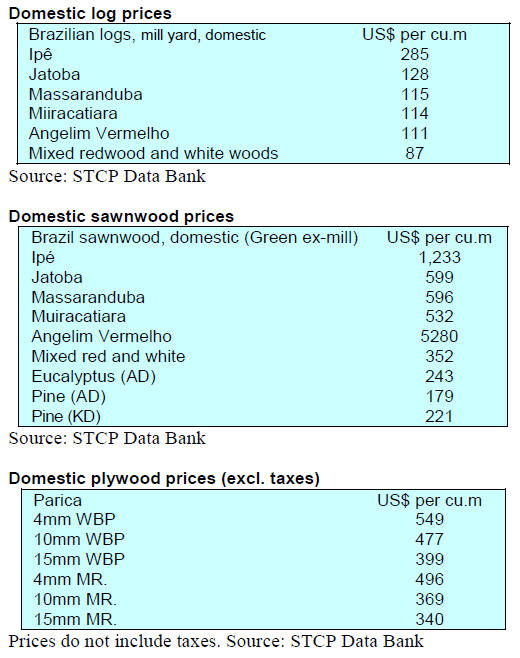
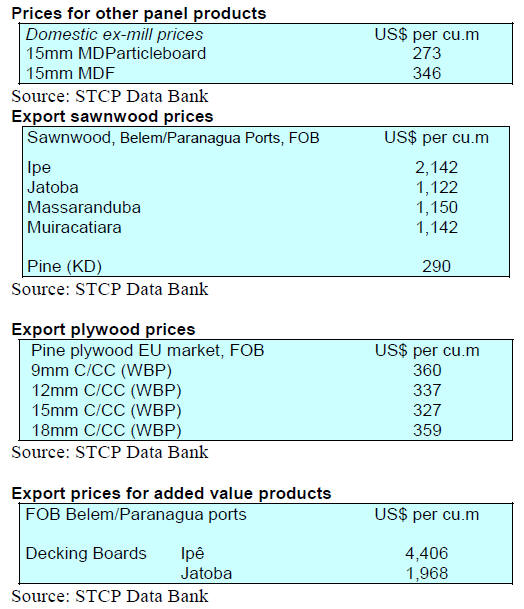
9. PERU
Good start to 2022 – exports rise
35%
The Management of the Services and Extractive Industries
Division of the Association of Exporters (ADEX) has
reported exports of wood products in the first 2 months of
the year totalled US$22.4 million, an almost 35% growth
compared to the same period of 2021. This increase is
explained by a stronger demand from countries such as
France, Dominican Republic and Belgium.
Despite the increase shipments of wood products barely
represented 0.7% of total non-traditional shipments, a
situation that does not coincide with the enormous
potential of the forestry sector.
Lucía Rodríguez Zunino from ADEX said “The
Amazonian forests represent 61% of the national territory
but this resource is not being well utilised, on the contrary
they are victims of deforestation”. He concluded that it is
essential that the revised process for forest concessions
allocation be implemented.
Despite reduced purchases China remains the main
buyer
With a 21% share of total export demand in the first two
months of 2022 China remains the main market for
Peruvian wood products followed by France, the
Dominican Republic and Belgium. Other buyers in the top
ten were Mexico, USA, Denmark, Vietnam, the
Netherlands and Germany.
In the first two months of 2022 semi-manufactured
products (US$13.6 million) were the largest and grew 28%
year on year representing 61% of total wood product
exports. The most outstanding items were: mouldings,
unassembled slats for flooring and other profiled wood.
With a 28% share, sawnwood (US$6.2 million) was the
second most exported product. In the first two months of
the year exports of sawnwood jumped over 50%.
Serfor and information exchange protocol
The National Forest and Wildlife Service (Serfor) and the
Regional Government of Loreto have signed a cooperation
protocol that will allow the exchange of geographic
information to ensure the sustainable management of
forest and wildlife resources in the department of Loreto.
The protocol was signed by the executive director of
Serfor, Hilario López Córdova and the Regional Manager
of Forestry and Wildlife Development of the Regional
Government of Loreto, Óscar Llapapasca Samaniego.
For nine months specialists from both institutions worked
to consolidate and harmonise the forest registry database
which will allow the sharing of information on the
effective management of the forest resources of the
department of Loretto.
During the signing ceremony a demonstration of the
spatial forest information system involving Serfors
GEOSERFOR platform and in the Spatial Data
Infrastructure (IDER) of the Forest Management of the
Loreto Region (GOREL).
